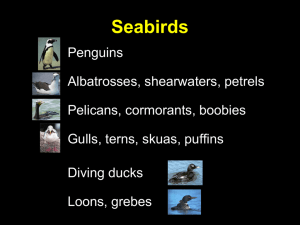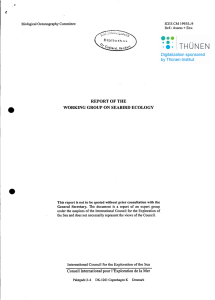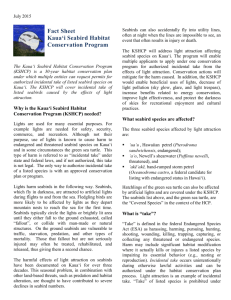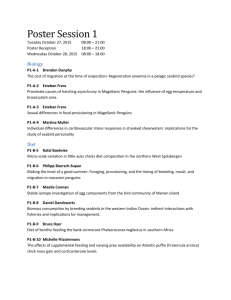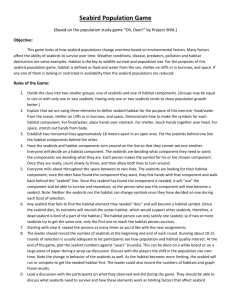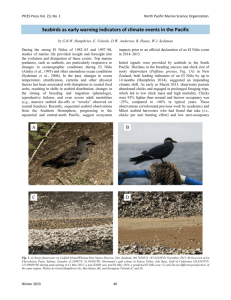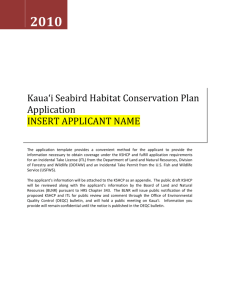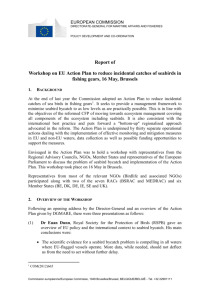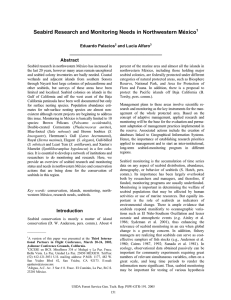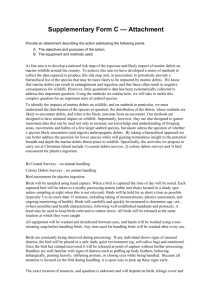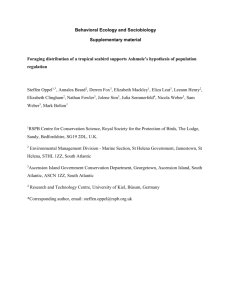Background paper seabird priorities final. - East Asian
advertisement
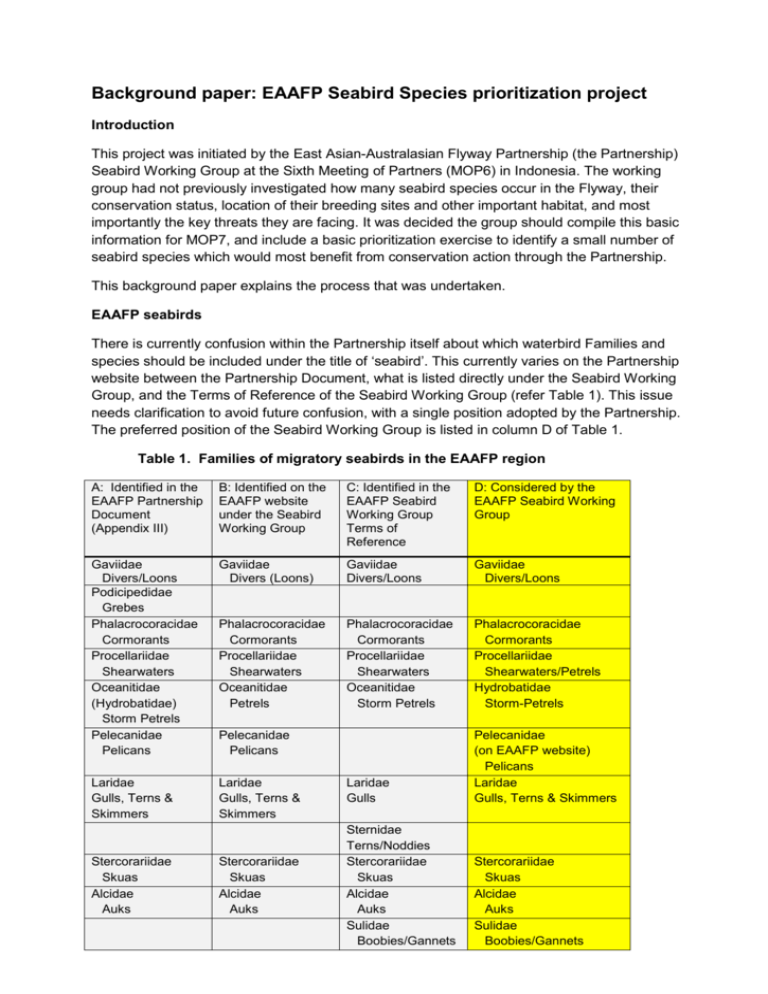
Background paper: EAAFP Seabird Species prioritization project Introduction This project was initiated by the East Asian-Australasian Flyway Partnership (the Partnership) Seabird Working Group at the Sixth Meeting of Partners (MOP6) in Indonesia. The working group had not previously investigated how many seabird species occur in the Flyway, their conservation status, location of their breeding sites and other important habitat, and most importantly the key threats they are facing. It was decided the group should compile this basic information for MOP7, and include a basic prioritization exercise to identify a small number of seabird species which would most benefit from conservation action through the Partnership. This background paper explains the process that was undertaken. EAAFP seabirds There is currently confusion within the Partnership itself about which waterbird Families and species should be included under the title of ‘seabird’. This currently varies on the Partnership website between the Partnership Document, what is listed directly under the Seabird Working Group, and the Terms of Reference of the Seabird Working Group (refer Table 1). This issue needs clarification to avoid future confusion, with a single position adopted by the Partnership. The preferred position of the Seabird Working Group is listed in column D of Table 1. Table 1. Families of migratory seabirds in the EAAFP region A: Identified in the EAAFP Partnership Document (Appendix III) B: Identified on the EAAFP website under the Seabird Working Group C: Identified in the EAAFP Seabird Working Group Terms of Reference D: Considered by the EAAFP Seabird Working Group Gaviidae Divers/Loons Podicipedidae Grebes Phalacrocoracidae Cormorants Procellariidae Shearwaters Oceanitidae (Hydrobatidae) Storm Petrels Pelecanidae Pelicans Gaviidae Divers (Loons) Gaviidae Divers/Loons Gaviidae Divers/Loons Phalacrocoracidae Cormorants Procellariidae Shearwaters Oceanitidae Petrels Phalacrocoracidae Cormorants Procellariidae Shearwaters Oceanitidae Storm Petrels Phalacrocoracidae Cormorants Procellariidae Shearwaters/Petrels Hydrobatidae Storm-Petrels Laridae Gulls, Terns & Skimmers Laridae Gulls, Terns & Skimmers Laridae Gulls Pelecanidae (on EAAFP website) Pelicans Laridae Gulls, Terns & Skimmers Sternidae Terns/Noddies Stercorariidae Skuas Alcidae Auks Sulidae Boobies/Gannets Stercorariidae Skuas Alcidae Auks Sulidae Boobies/Gannets Stercorariidae Skuas Alcidae Auks Pelecanidae Pelicans Stercorariidae Skuas Alcidae Auks Fregatidae Frigatebirds Diomedeidae Albatrosses (3 nth. hemis. spp) Fregatidae Frigatebirds Phaethontidae Tropicbirds Diomedeidae Albatrosses (3 nth. hemis. spp) Note: Penguins (Order Sphenisciformes) are also seabirds, but are not relevant to the Partnership. Croxall et al. (2012) in a global assessment of seabird status follow the taxonomy of Birdlife International (www.birdlife.org/datazone/home), and define seabirds as ‘species for which a large proportion of the total population rely on the marine environment for at least part of the year’. We followed this definition to identify relevant seabird families, but include some additional species that are sometimes not considered seabirds. These species have similar ecology to true seabirds, but live largely in estuarine or freshwater lake and river environments. Thus, a small number of species such as the Indian Skimmer Rynchops albicollis are included, as it belongs to the Laridae Family with gulls and terns and feeds exclusively on fish and shrimps. Such species are important migratory waterbirds in the Flyway and are unlikely to be considered by the Partnership under any other waterbird group. We used distribution maps in del Hoyo et al. (1996) and BirdLife’s digitised species’ distribution maps to confirm occurrence of seabird species in the Flyway. A complete list of the seabird species identified from the Flyway is presented in Attachment A. The Prioritization Process Some Flyway seabird species are subject to the Agreement on the Conservation of Albatrosses and Petrels (ACAP), which is a legally binding international treaty signed in 2001. While these species have been listed in this paper, most have not been included in the prioritization process because they are the subject of coordinated conservation effort under that agreement (refer species at the bottom of the spreadsheet in Attachment A). Three ACAP listed species, all northern hemisphere albatross, are included because they have important breeding sites within the Flyway. Other Southern Ocean seabird species such as Antarctic Tern, which do not breed within the Flyway, are also excluded from the prioritisation process. The working group is also mostly avoiding issues associated with the commercial fishing industry by focussing on impacts at important seabird breeding and migration sites. The Partnership is concerned only with migratory waterbirds. Seabirds not considered to be migratory are therefore not included in this prioritisation process. These species, together with those not known to breed within the Flyway, are identified in light green in Attachment A. The final group of seabirds not included in the prioritization process are those with an IUCN Red List classification of Least Concern. While these species have not been prioritized at this stage, they remain on the Partnership list of migratory seabirds for possible future scrutiny. This leaves 39 seabird species at the top of Attachment A (coloured IUCN status). These have been given a priority from five down to one (coloured yellow) using the rules in the Legend (Attachment B). Further differentiation is indicated under ‘Conservation plans’, where species with no conservation plans are coloured varying shades of grey according to their calculated priority. 2 It is intended that this combination of ‘priority’ and ‘availability of conservation plan’ will be adopted by Partners as a guide to future seabird conservation action. It will be used to inform annual work plans for the working group, and should be reassessed periodically as an assessment of progress with conservation of seabird species in the Flyway. References: Croxall, JP, Butchart SHM, Lascelles B, Stattersfield AJ, Sullivan B, Symes A, Taylor P (2012) Seabird conservation status, threats and priority actions: a global assessment. Bird Conservation International 22: 1-34. del Hoyo J, Elliott A, Sargatal J (1996) Handbook of the Birds of the World, Lynx Editions, Barcelona, Spain 3
